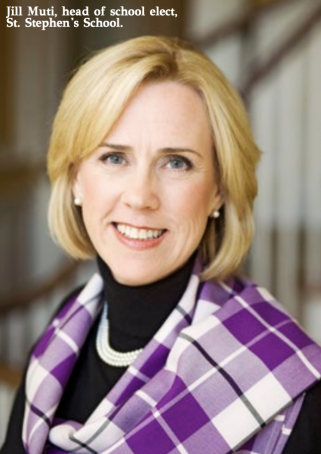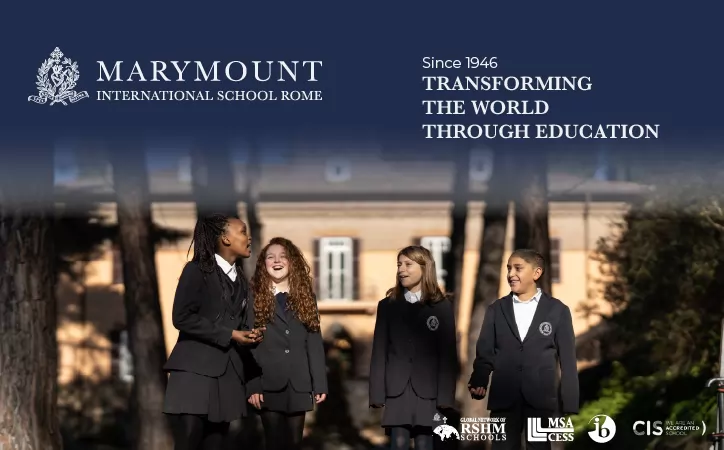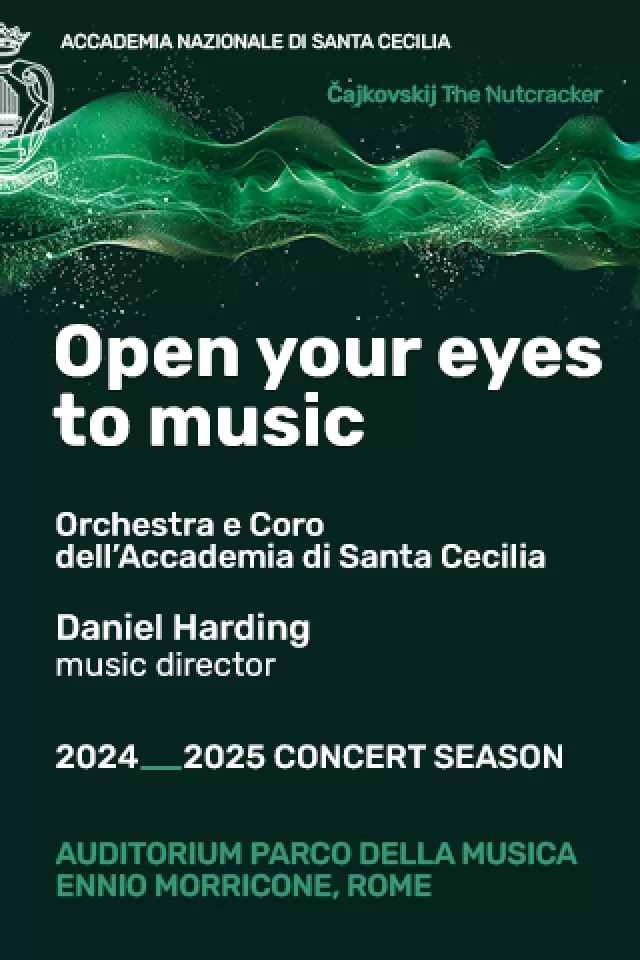The future head of St. Stephen’s talks to Wanted in Rome

What is your background and what are your goals in this new adventure as Head of St. Stephen’s School?
I am really looking forward to moving to Rome and becoming the next Head of St. Stephen’s School. Each school has its own unique culture and community. Initially, I think it’s going to be crucial to learn the school’s culture, be visible, ask questions and praise effective teaching and learning practices. It’s equally important to remember the number one reason we are here is for the students.So, I would say that my primary goal is to maintain and ensure our level of academic excellence by creating the best atmosphere for learning by focusing on what is best for our student body and helping them create a unique, unforgettable secondary experience. I look forward to getting to know the community, building authentic relationships with my colleagues, creating effective teams, and empowering faculty and staff to carry out their responsibilities successfully.
Should there be underlying problems and issues to solve, I will want to take immediate action to remedy situations that might arise. Still, my priority will be to focus on what is essential rather than urgent every day. St. Stephen’s is getting ready to embrace a new strategic plan, and I am looking forward to stewarding the plan and process to guide the school successfully into the future. Everybody in our school, from the head of school and the board of trustees down to the support staff, must keep our school in the vanguard of change.My ultimate goal is to leave St. Stephen’s in a better place so that it can continue to attract intellectually-motivated students from around the world for years to come. For the last 18 years, I have been the Head of Ashley Hall in Charleston, South Carolina, a P-K - 12th-grade independent school for girls serving 685 students. I have managed the budget, staffing and all aspects of student life and have had hands-on leadership in virtually every dimension of the school’s programme, including strategic planning and development.
Ashley Hall is a community I have loved serving. During my time there, I initiated and implemented numerous programmatic enhancements, including STEAM initiatives, the integration of math and science departments, the vision and creation of a global studies program, a successful professional development programme, a boarding programme for international students, a health and wellness programme, among many others. I have led three capital campaigns and three productive strategic and master planning processes and tripled the school’s endowment.
I am also proud of a partnership I launched with Horizon’s National, a non-profit that works with schools to develop summer academic, enrichment and social-emotional learning programmes to serve underrepresented students. Before joining Ashley Hall as Head of School, I was Assistant Head at Ravenscroft School, a P-K-12 in Raleigh, North Carolina. There I implemented the school’s strategic plan, led the faculty hiring process, created an interim programme for the Middle and Upper School, administered all phases of the Fine Arts Programme P-K-12, and oversaw the design and construction of a $2.6 million Fine Arts Center.
I also held the positions of College Counselor, Coordinator of International Programs, Director of Fine Arts Center, and Chair of Fine Arts. My other professional experience includes being a member of the Adjunct Faculty at NC State University, Raleigh, North Carolina, and Admissions Officer at Duke University, in Durham, North Carolina.
What does St. Stephen’s offer that other international schools in Rome don’t?
There are several reasons St. Stephen’s School is unique. First, we are the only coeducational, American international high school in the centre of Rome offering day and boarding to students in grades 9 through 12.Second, St. Stephen’s has an incredible location. We are adjacent to FAO (Food & Agriculture Organization), a three-minute walk to Circus Maximus, and about a five minute walk to some of the most significant monuments of ancient Rome – the Colosseum and Roman Forum. No other school in Rome can boast a location like ours.
Third, we are the oldest IB World School in Italy, and our graduates have consistently ranked in the top percentile of IB exams, including perfect scores of 42 and the highest IB scores in the history of the school in recent years. Our average IB score is 36. Over a student’s four years, there are 120 courses students can choose, reflecting the school’s proud tradition of academic excellence that brings all the best elements of an American and international education tradition to our student body.
This commitment to academic excellence was solidified in 1975 when St. Stephen’s became the first school in Italy (the seventh in Europe) to offer the International Baccalaureate Programme to students in grades 11 and 12. Fourth, with our small size of 300 students, we can get to know and work one-on-one with each student, build strong relationships, and cater to each young adult’s needs by offering a rigorous tailor-made programme that fulfills the full International Baccalaureate Diploma Programme requirements and a US high school diploma. We provide a stimulating and culturally diverse environment to almost 60 nationalities from five continents, fostering a sense of internationalism and global citizenship. We nurture the whole student with counseling and wellness support and a robust advisory programme.
We balance this with a diverse co-curricular offer. Fifth, rounding out our academic offer are the school’s unique signature programmes that allow students to develop inquiry-based lab skills and participate in university-level research with state-of-the-art equipment so they may expand and deepen their scientific literacy and competencies through St Stephen’s Molecular Genetics program; explore enriched classics courses through the Dr. Helen Pope Lyceum Institute for Roman Culture, where students may elect to study Latin, Classical Greek and Roman Studies, or Arabic; enhance their technology skills in the iLab as they learn to design, programme, build, and compete in robotics using EV3 Lego Mindstorm or Tetrix Java-based robots, have virtual reality experiences, make their own Virtual and Augmented Reality applications using iLab programs and specialised cameras, and learn about creating and using Artificial Intelligence; and explore the world around them through our school-wide trips programme, which enables discovery of cultures and regions throughout Italy, Europe and the Mediterranean Basin twice a year.
Paired with summer service-learning experiences in Africa, South East Asia and Eastern Europe, students benefit by gaining new insights and developing a global mindset balanced with compassion and consideration for others. Sixth, a strong commitment to our core values of care, integrity, scholarship, independence and creativity defines us and provides an essential foundation for building character. Students feel supported and free to achieve their personal best. And lastly, I would say the school’s world-class faculty make us stand apart because we employ working professionals in many sectors who have distinguished themselves in their respective fields. 90 per cent of our teachers have advanced degrees, and 20 per cent have Ph.Ds.How has covid affected the school and the number of students?
Like all schools around the world, St. Stephen’s has had to navigate the diverse challenges of the pandemic. Though I was not present last year at St Stephen’s, I have been informed that the school transitioned to online learning, perhaps with a few hiccups at first, but eventually learned to accommodate students with asynchronous learning. My predecessor, Eric Mayer, and his Senior Leadership Team created a Covid Response Center, worked the phones with parents, teachers and students, and created clear lines of communication, hired a Covid Manager, organized Zoom meetings with prospective families, assembled a medical advisory team, and kept the community spirit going through wellness meetings.This collaborative approach worked when the school resumed teaching and learning in person. Communication and cooperation across departments have been vital in maintaining the school’s overall enrollment of 300 students. Recruitment targets remained very strong throughout the pandemic, the school continues to be fully enrolled, and there is increased demand. The pandemic, in general, has had a tremendously negative effect on secondary students around the world. And while school communities have adapted and created new strategies to teach material, the isolation and lack of social interaction have had a tremendous effect on students in general. Schools like St. Stephen’s that have weathered this storm and been able to serve the student body are a remarkable testament to the dedication of the school community, especially the faculty and staff.What countries are represented in the student body? Where do the majority of students come from?
60 nationalities represent the student body at St. Stephen’s. One-third of our students are from North America. Nearly every country in Europe is represented, and Europeans make up approximately 40 per cent. The rest of our student body comes from China, Central and South America, the Middle East, and Africa.What role does the school’s location in an archaeologically rich area play in students’ studies?
Our English language high school is surrounded by Western Civilization’s most significant historical monuments and museums. The Colosseum, the Roman Forum, and Circus Maximus are all within minutes of our campus. Teachers use the Eternal City as their classroom. It’s not unusual for students in art or history, science, even math or Latin to spend their class time walking through the streets of Rome, exploring ancient churches, reading inscriptions, and having an opportunity to touch and feel history.St. Stephen’s teachers use Rome every week in their lessons. This first-hand knowledge of history, art, archaeology, classics and cultural heritage is a unique signature of a St. Stephen’s education, which provides an intellectually challenging environment that transforms young minds and prepares them to excel in high school and their future endeavours. It’s a one-of-a-kind experience.
How many students are boarding and what is the future of a boarding institution?
St. Stephen’s currently has 50 boarders at the school. Due to the success of our boarding programme, there are plans to expand our boarding offer in the coming years. We are an urban high school, and as I mentioned earlier, that makes us different from other schools in Rome. Indeed, our boarding community has benefitted from being in the historic centre in many ways.The Board of Trustees firmly believes that our inclusive community of scholars will only be further enriched culturally and philosophically by students who bring diverse experiences from their varied backgrounds. I look forward to collaborating with the board, the Head of Boarding, and the Director of Marketing and Admissions to further define the boarding experience at St. Stephen’s.
Will St. Stephen’s International school ever expand to primary level?
I am not aware of any discussion to expand the grades represented at the school. I believe we plan on maintaining our unique presence as a high school.Where do most students go after St. Stephens?
St. Stephen’s has shaped the futures of students since 1964. Over 5,000 graduates have matriculated to leading universities worldwide and distinguished themselves as leaders and pioneers in their professional careers. St. Stephen’s students have the opportunity to attend the best colleges and universities in the world.We work closely with students to highlight their individuality and their passions, provide strategic guidance throughout the application process, increase college admissions competitiveness, and help students and their families make informed decisions about which college or university is the best fit for them. The following is a list of just some of the colleges and universities throughout the world where our students have matriculated in 2021.What are you looking forward to the most about living in Italy?
My husband is Italian and we spend a great deal of time in Italy. I am looking forward to living in the “Eternal City” and learning as much as I can about its incredibly rich history.For more information about St. Stephen’s School, see website. Press, marketing, and admissions inquiries may be directed to Courtney Ventura, Director of Communications, Marketing & Admissions.
General Info
View on Map
Interview with Jill Muti, head of school elect, St. Stephen’s School.
Via Aventina, 3, 00153 Roma RM, Italy


















